Arc welding is as easy as it gets as long as you have a proper power supply. However, once the repair operations, jobs, and tasks move outdoors or to remote job site locations, you might find yourself in a stalemate.
That’s when engine-driven welders kick in, as they use diesel, petroleum, or LPG fuel to generate the power.
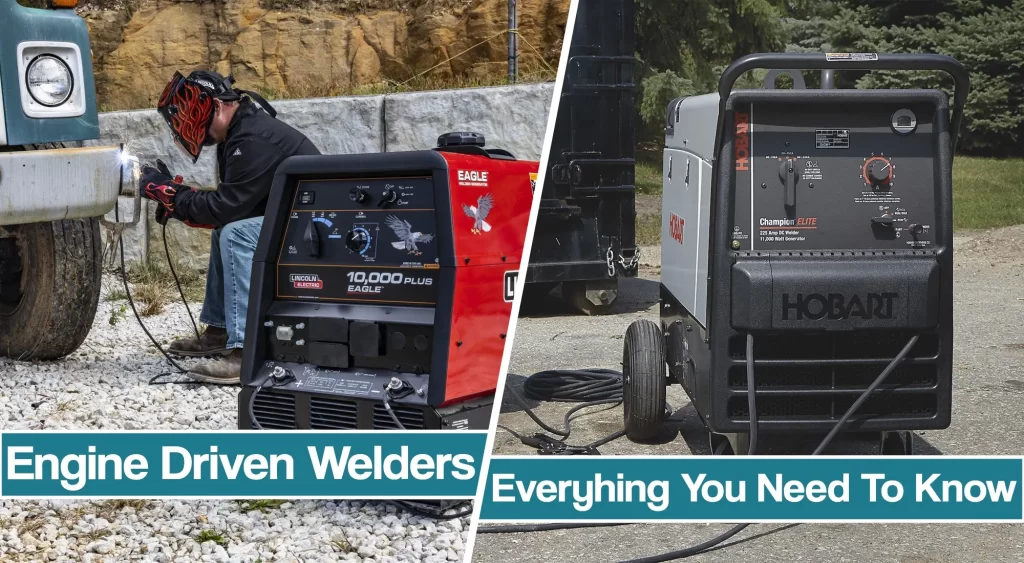
This stand-alone generator will allow you to perform standard arc welding processes such as stick welding, MIG welding, or TIG welding, increasing the overall versatility. Let’s explain what engine driven welder is, how it works, and how to choose one.
What Is an Engine Driven Welder?
Engine-driven welders use fuel, such as diesel, petroleum, or LPG, to create the power required for Stick, TIG, MIG, and Flux-Cored welding.
Apart from welding, these machines can be used as stand-alone generators that can power your compressor, hydraulic pumps, and battery jump-start terminals.
Overall, these are highly versatile machines you can use in case there is no electric power nearby.
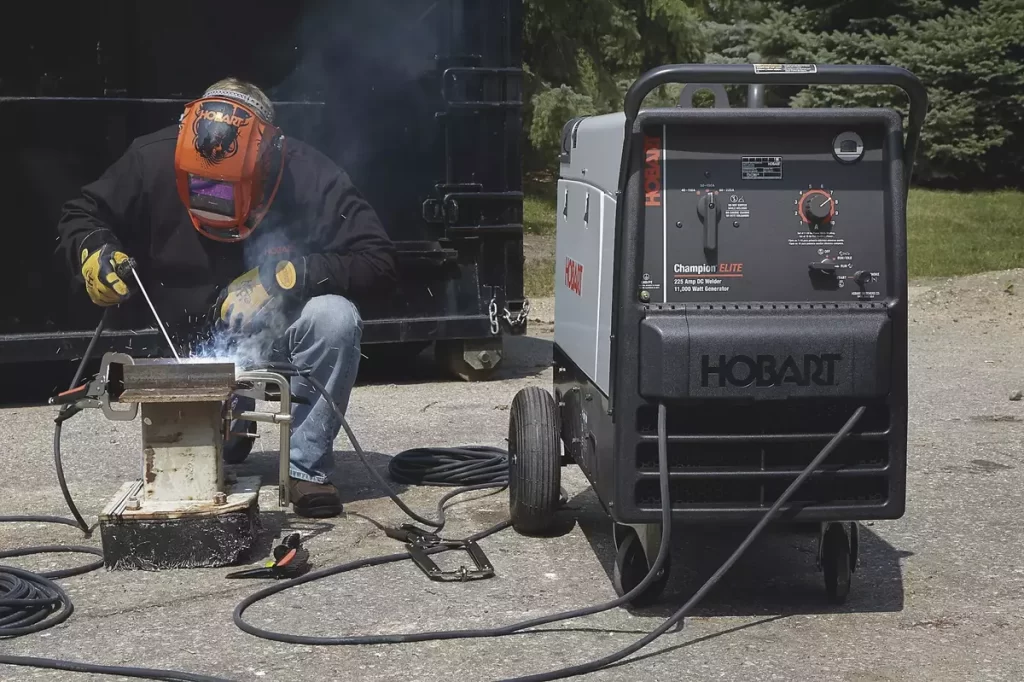
While engine-driven welders are commonly considered outdoor welders, you can also use them inside, but with caution. Since they burn the fuel to create power, you should only use them in a well-ventilated area.
Most engine-driven welders, besides a welding generator, offer several more capabilities. As a result, you can even get a four-in-one machine capable of doing multiple welding processes and supporting a compressor, hydraulic pump, or battery charger.
Types Of Fuel And Fuel Efficiency Engine Driven Welders Use
Engine-driven welders can use petroleum, diesel, or LPG fuel. Each type differs in fuel efficiency, costs, and ecological factors. Therefore, before making a choice, you should carefully read the following text.
Diesel Welders
Diesel welders, as their name states, use diesel fuel to run the electric fuel pump. As a result, they are capable of outputting welding power higher than 300 amps, making them a real outdoor workhorse.
In addition, diesel welders are 35% more fuel-efficient than petroleum welders. Therefore, they use less fuel to create more power and run longer.
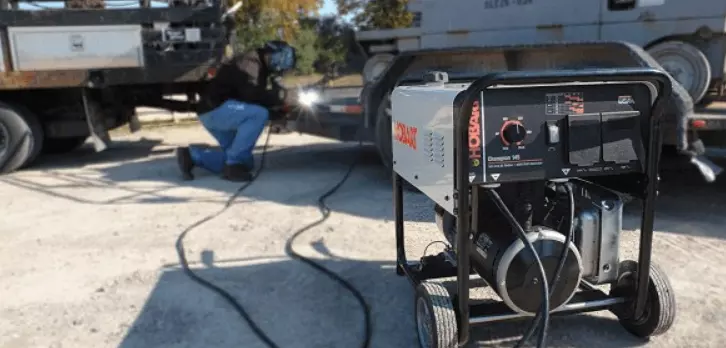
Besides efficiency, diesel welders require lower maintenance than other engine-driven welders. In addition, diesel fuel ignites harder compared to petroleum, so therefore, they are considered safer for the shop. Even though they are pricier than petroleum welders, they tend to last more. The work hours of a diesel welder last from 3,200 to about 15,000 hours to its maximum.
However, diesel fuel is pricier compared to petroleum, especially in today’s fuel economy, and it is not an environmentally friendly option. So while the welder runs, the emission is hazardous to the environment and welders. In addition, diesel welders tend to be loud, so noise pollution is possible.
Pros of Diesel Welders
- Better fuel efficiency
- High generator power means high welding output
- Overall efficient
- Industry workhorses
- Lower maintenance costs
- Considered safe for the shop
Cons of Diesel Welders
- High fuel prices
- Burning diesel creates environmental and operator hazards
- They can be loud
- Bulkier and heavier industrial machines
Petroleum Welders
While diesel welders are industrial workhorses, petroleum welders are somewhat more compact and lighter but aimed at lower-duty jobs.
As a result, they are suitable for farm and ranch owners. The welding power is commonly limited to 300 amps, but they can be used to weld mild and stainless steel on the field with ease.
Due to limited power, petroleum welders carry an initially lower price than diesel welders.
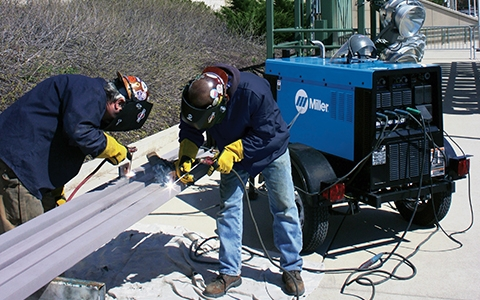
However, petroleum fuel efficiency is significantly lower than diesel; therefore, the overall costs are somewhat similar. In addition, petroleum burns hotter, producing higher RPMs. High RMP means there is more wear and tear, so the maintenance costs are higher. As a result, working hours could vary from 2,200 to 3,000 hours.
The ignition properties of petroleum fuel have their ups and downs. For example, since petroleum ignites faster, it is unsuitable for work in high-temperature and hot climates. On the other hand, petroleum welders are ideal for working in cold weather and cold temperature.
Pros of Petroleuum Welders
- Lower initial price
- Compact and lightweight
- Suitable for cold weather climates
- Economical choice for low to medium duty applications
Cons of Petroleum Welders
- Lower fuel efficiency compared to diesel welders
- High wear and tear with higher maintenance costs
- Not suitable for work in high-temperature conditions
- Lower lifespan due to higher wear
LPG Welders
LPG (Liquid Petroleum Gas) welders are not so common but are a go-to choice for indoor applications. Why? Because burning LPG doesn’t cause toxic emissions and fumes. Clean fuel means a clean environment, making it an ideal choice for environments where gasoline and diesel emissions are unacceptable.
Unlike gas and diesel engine welders, liquefied petroleum gas (LPG) engine welding generators utilize a fuel source that doesn’t deteriorate over time. As a result, they carry lower maintenance costs.
Welding Output And Duty Cycle Of Engine Driven Welders
Like any regular welder that uses electricity to create welding arc, engine-driven welders also have rated welding power and duty cycle.
As we noted above, most petroleum welders are rated at less than 300 amps, while diesel welders offer power higher than 300 amps. Therefore, before buying an engine-driven welder, you should first set your goals straight.
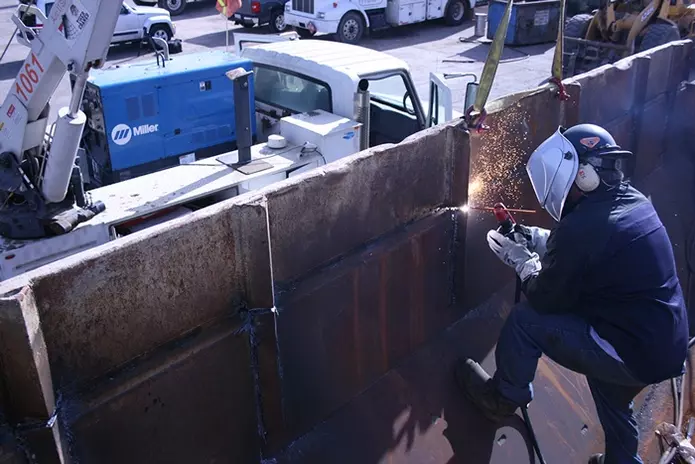
However, rating an engine-driven welder is not as easy as with regular electricity-powered welders. Why? Because there are several different ways to rate the auxiliary power of the machine. That’s why you should make difference between peak power and continuous power, single phase and three phase power, as well as auxiliary power and continuous welding power.
Difference Between Peak Power And Continuous Power
The peak power of the engine-driven welders is always the highest power it can produce, but you should keep in mind that it lasts very short. Therefore, the power peaks for the first 30 seconds, so you can start up some power-hungry machines such as pumps.
After the peak power, engine driven welder continues to work at continuous power. That power is usually rated by a 100% duty cycle, and it starts after the initial surge. So when looking at engine-driven welders, you should make a difference between the initial surge and continuous power your will actually use for your welding.
Single Phase and Three Phase Welding Generator
Single-phase and three-phase sources are fundamentally different, so while some power tools require single-phase, some welders can demand a three-phase source. If the engine-driven welder’s rated power rises, it will most likely need a three-phase source.
Therefore, consider the tools and welders you will use out of generator power, and adjust the choice of a single-phase vs. three-phase machine.
Auxiliary Power in Welding
Engine welders use fuel to generate auxiliary (AC) power that can be used to run lights, pumps, power tools, and other devices. In other words, the auxiliary power is your engine-driven welder’s maximum power. On the other hand, welding power shows your welder’s capability, so you shouldn’t mistake these two.
As the welding output rises, the auxiliary power goes down, so there are fewer devices, such as air compressors, that can run simultaneously during welding. That’s why understanding the different types of power your engine-driven welders provide is essential.
How Much Welding Power Do You Need?
Determining the required welding output solely depends on your common applications, the complexity of projects, and the thickness of the materials you are about to weld. For example:
- Stick welding with 5/32 electrodes is commonly done at 200 amps or less, but if you weld thicker materials, you will need a bigger and more powerful welder.
- TIG welding is a constant current process that usually won’t require more than 200-300 amps.
- Flux core welding is a common choice for outdoor welding, but the self-shielded wire requires a constant voltage (CV) power source rated at 300 amps or higher.
- Arc gouging is a power-hungry procedure that will require more than 300 amps output, and sometimes even more than 450 amps.
Besides the welding output of engine-driven welders, you will also need to look for the duty cycle. The duty cycle will tell you how long you can weld before the engine-driven welder overheats and shuts down, and it is rated using the IEC rating. IEC formula will show you how long you can run a welder at a specific amperage and voltage.
Engine Driven Welder Manufacturers
When buying a common, electricity-powered welder, you can usually look for the best value for the price.
However, an engine-driven welder is a complex device, so I recommend looking for brand-name welders from Lincoln Electric, Miller, or Hobart.
Engine-driven welder such as Miller trailblazer 325 or Miller Big Blue 400 Pro offers excellent reliability and capability.
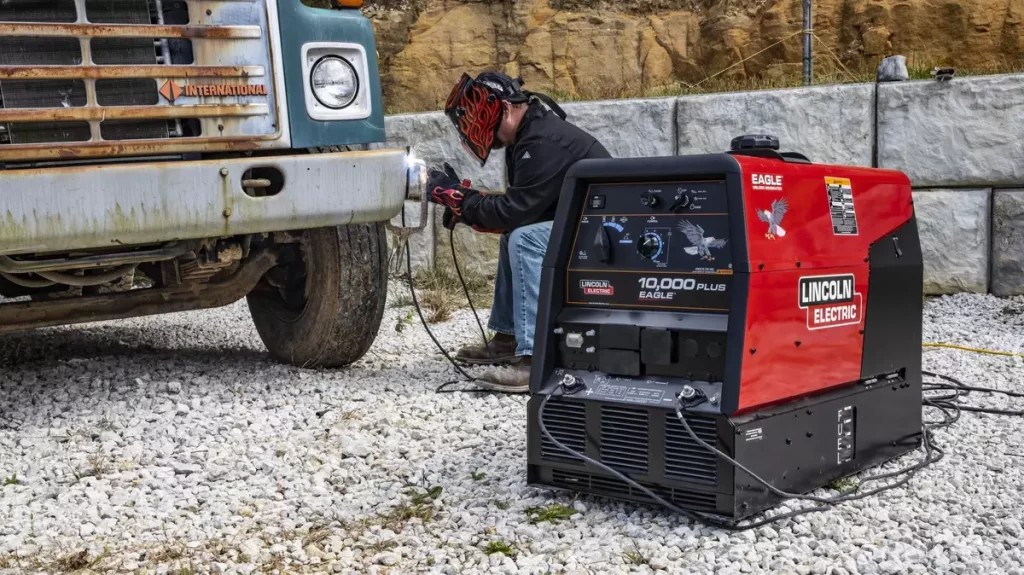
The manufacturer claims they are up to 52% more fuel efficient and 17% lighter and smaller than the competition. In addition, they offer some state-of-the-art features such as remote start, aluminum work capability, and much more.
However, the biggest advantage of brand-name engine-driven welders is the easier maintenance. Service networks can vary by location, so look for an engine manufacturer that has a nearby service.
In addition, brand-name welders, such as Miller Bobcat 225, calculate the IEC rating correctly. Comparison-wise, off-brand welders can misguide buyers by promoting significantly higher ratings, resulting in failure during operation.
Resources:
- https://www.lincolnelectric.com/en/welding-and-cutting-resource-center/welding-how-tos/choosing-the-right-engine-driven-welder
- https://ronsonstorch.com/choosing-the-right-engine-driven-welding-machine/
- https://www.lindedirect.com/solutions/construction-site-solutions/engine-driven-welders
- https://blog.red-d-arc.com/generators/the-benefits-of-using-an-engine-driven-welder-generator/




